
Related
We speak with Joshua Yaffa, longtime Moscow correspondent for The New Yorker, who has just left Ukraine after reporting on the Russian invasion for the past two weeks. He says Russian attacks in Ukraine are becoming increasingly indiscriminate as the army is unable to take over the capital of Kyiv to facilitate Putin’s goal of a regime change, noting, “Putin has raised the stakes for himself so extraordinarily high that I don’t think he’ll be convinced to back down based on something like street protests.” He also describes support from Ukrainian civilians for a no-fly zone, which many fear could start a war between the U.S. and Russia and increase the likelihood of a nuclear disaster.
Transcript
AMY GOODMAN: This is Democracy Now! I’m Amy Goodman. As we continue our coverage of Russia’s invasion of Ukraine, we’re joined by Joshua Yaffa, a contributing writer to The New Yorker who has been the magazine’s Moscow correspondent since 2016. He just left Ukraine this weekend after reporting on the Russian invasion for the past two weeks. His latest piece is headlined “What the Russian Invasion Has Done to Ukraine.” Josh Yaffa is also author of the book Between Two Fires: Truth, Ambition, and Compromise in Putin’s Russia.
Joshua, welcome back to Democracy Now! OK, no soundbites here. Take us on your journey. Among the places you go to are the hospitals of Ukraine, and what this invasion means for so many vulnerable people.
JOSHUA YAFFA: Thanks for the invitation, and I’m happy to be with you today.
I started this current reporting trip in Ukraine, where I had been many times over the years, been going to Ukraine over the last decade on successive reporting trips and really come to love the city of Kyiv and the people and much of the country that I got to see in those years. This time I started my journey in early February. This is still several weeks before the invasion began, when it was difficult for people both in Moscow and in Kyiv to believe that such a thing was possible. In Kyiv, people were not doubtful or skeptical of the possibility of invasion because they had any illusions or doubts about the intentions of Vladimir Putin regarding their country, but simply the thought of a wholesale or large-scale land invasion with Russian forces streaming into the country from several sides, with air raids, missile strikes and so on, just seemed an unbelievable prospect. And it stayed that way right up until the days before the invasion. I think the seriousness and likelihood and even imminence of the war really only sunk in in the three or four days before it began.
I had myself gone to Donbas in eastern Ukraine. This is an area that has seen war with Russia for many years, going back to 2014, when, having annexed Crimea, Russia launched a would-be separatist war backing rebel militias in the Donbas, leading to a war that really went on into the current day, a war that never really ended but was limited to these eastern territories in the Donbas region of Ukraine. And many people, myself included, thought that if there were to be a new invasion, that it would probably start in the Donbas. It would emanate out of these regions that have already seen fighting between Ukrainian forces and Russian forces and Russian-backed proxies. And so, I was in the Donbas on the eve of the war, expecting that if there was to be an escalation, it would happen there.
Instead, I was woken up at 5 a.m. to the thunderous sound of missile strikes hitting the city of Kramatorsk in the Donbas, where I was at the time. And when I woke up at 5 a.m. to the sound of these missile strikes hitting nearby, I opened my phone and looked at the news and saw, on the one hand, that Putin was delivering this early-morning speech in Moscow declaring the start of what he called a “special military operation,” but what in fact was clearly an invasion and clearly a war, and that strikes were happening all over the country, in Kharkiv, in Kyiv, even in the west of the country, the areas that few thought the Russian invasion would reach.
And from there, very quickly, we understood the scale of this attack and the scale of Russia’s intentions, what Putin was trying to achieve here. I think in the early days of the war, as your previous guest has spoken to and you’ve discussed on the show prior, Putin was looking to do regime change here. He wanted to overthrow, with military force, the government of Volodymyr Zelensky, install a pro-Russian regime. And the way to do that, first and foremost, was taking the capital, taking Kyiv, and also decimating Ukrainian military infrastructure and seizing other Ukrainian cities.
And once I understood the true scale of this invasion and its aims already on the first day, having woken up to the sound of bombs in Kramatorsk, I made my way to Kyiv with some colleagues, with a photographer, Emanuele Satolli, that I was working with. It took us two days to reach Kyiv driving by car all the way from Donbas, with highways clogged with families trying to flee the fighting, Ukrainian military equipment, tanks and armor going in the other direction trying to reach the front, and eventually made our way to Kyiv, where I spent the next 10 days waiting for a siege that never quite happened. Your previous guest spoke to this, to the fact that Russian forces, on a number of sides, have surrounded Kyiv. There’s heavy fighting going on to the northwest, some to the east, increasingly to the west. The southern direction remains open. That’s a key artery, in fact, the only way in or out of the capital and how I eventually left. I can talk about that in a few minutes.
But Kyiv was a city transformed. I had been away for only four or five days since I departed on my trip to the Donbas on the eve of the war. I returned to a ghost town, really, a city marked by checkpoints every few hundred meters, in some cases, whether they were manned by Ukrainian soldiers or members of the so-called Territorial Defense Forces. These are volunteer fighters. The Territorial Defense Force has received tens of thousands of volunteers since the start of the war. These are people who some weeks ago were IT programmers, school teachers; one person I met had worked in a company manufacturing equipment for agricultural sector — all who had taken up weapons, undergone minimal training, and with no time really for much more, and being sent out, if not to the frontlines, at least to guard their own neighborhoods and stand at checkpoints. Kyiv is a city under curfew. In the early days, it was difficult to find a pharmacy, to find a grocery store. And there was this feeling that any day now the Russians could enter. That was certainly the military prognosis in the early days.
And it’s been a surprise, I think, to the Russian army, to Putin, and perhaps even to Ukrainians themselves, the degree to which the Ukrainian military, if we look a place like Kyiv, has been able to keep Russians from entering the city. There’s heavy and tragic fighting happening in a number of suburban towns — Irpin, Bucha, Brovary, to name a few — where we’ve seen fighting that has left civilians dead, that has destroyed much of the city infrastructure, people’s homes. But as I’ve said, that fighting, at least on a large scale, hasn’t entered Kyiv itself.
I saw evidence of a number of firefights that had in fact happened inside the center of the city. These were attempts by Russian forces to penetrate quickly and stealthily into the capital, but they were repelled by Ukrainian forces. It seems like with Russia unable to succeed in what the former Ukrainian defense minister called a kind of raid, the sort of special operation to quickly seize Kyiv and to replace Zelensky, they’ve changed tactics and instead switched to a tactic of bombardment, of missile strikes, of airstrikes, that have — by definition, indiscriminate and are really laying waste to cities like Kharkiv in the north, northeast, Mariupol in the south, and also having a real — exacting a real toll on the outskirts of Kyiv, and increasingly Kyiv itself, as we saw with the strikes in the center of the city. Those strikes are, of course, affecting civilians, first and foremost.
You mentioned my time in the Ohmatdyt children’s hospital in Kyiv. This is the premier facility in the whole country for treating children. Before the war, it was the main center that accepted children from all over the country with various types of cancer, neurological disorders, other very serious ailments that needed urgent care. I visited this hospital on multiple occasions in my time in Kyiv. I got to know some of the doctors there. I walked the wards. I saw injured children whose faces were scarred and bloodied, the victim of shelling attacks, who had had shrapnel strike them in their neck and their face. Their family members were also in the hospital. I saw a young 13-year-old boy in a hospital bed with his face bandaged, his mother also injured lying next to them. Their other family members had died in this attack. There was a young boy named Semyon, who I went to see with one of the doctors on my first trip to Ohmatdyt. He was riding in his family’s car when it came under shelling attack. His parents died immediately. The boy was brought to the children’s hospital. No one knew his identity for several days. He was known as “unknown patient number one.” Eventually, the doctors were able to reach his grandmother and learned his name, Semyon. When I saw Semyon with the doctors at Ohmatdyt, he was in a coma with little brain activity, his face and much of his body wrapped in bandages. When I returned to Ohmatdyt children’s hospital two days later, I saw the same doctor in the hallway. I asked about Semyon’s condition, and he told me that Semyon had died, had succumbed to his injuries.
And these are just a small sampling of the kind of suffering facing civilians in Kyiv, and even more in other cities that I’ve mentioned, Kharkiv under incredible aerial bombardment, the city — the center of this historic city turned into something that resembles Stalingrad; Mariupol, where we’ve heard these extraordinary figures about thousands of civilian casualties, perhaps one in 40 of the prewar population of that city now dead. So, the suffering I saw in Kyiv really offered just a small glimpse, a kind of small portal, into what is happening in dozens of cities all over Ukraine right now.
AMY GOODMAN: I mean, your story is truly astounding. And as you tell us the story about Ukraine, back in Moscow, I wanted to get your response to the just astounding bravery of this employee of a longtime Russia state-owned television station, Channel One, bursting onto the set during Monday evening’s live news broadcast, holding a sign reading “no war,” in Russian and in English, “Don’t believe the propaganda. They’re lying to you here.” The protester is Channel One producer and editor Marina Ovsyannikova. She appeared on screen for several seconds — and I want people to listen — shouting, “Stop the war! No to war!” before the camera cuts away.
ANCHOR: [speaking Russian]
MARINA OVSYANNIKOVA: [speaking Russian] [Stop the war! No to war!]
AMY GOODMAN: So, can you talk about — we don’t know where Marina is right — we don’t know where Marina is right now. But the significance of this? And she said she’s been a part of the propaganda machine for a long time. And also explain the concept of what the Russian propagandists called “Russkiy Mir.”
JOSHUA YAFFA: Right. You’re absolutely right that this was an extraordinarily brave act. But before I talk about what — this moment from First Channel yesterday, I want to say that brave things or heroic things can be done by nonheroic people. And I think the real bravery in Russian journalism in recent years has been done by those who continue to work for independent outlets telling the truth about what was happening in Russia and abroad. These are friends and colleagues who work at places like Novaya Gazeta, whose editor-in-chief won the Nobel Prize this year, TV Rain, Meduza, BBC Russia and outlets that are now banned in Russia, forced to close, with their staff scattering all over the world facing legal repercussions. So, I think this act committed by a Channel One producer, who admitted herself she was part of the propaganda machine for many years, is an acute, isolated act of bravery, and she certainly should be commended for it, but I don’t — I wouldn’t want to confuse or give the idea that, you know, this act of bravery eclipses the much more persistent and long-standing, dedicated acts of bravery committed by Russian journalists who were never part of the propaganda machine.
That said, this action shows clearly that something is afoot inside the system — right? — that there is dissatisfaction, even dissent, bubbling to the surface, that those who are part and parcel of this propaganda machine, at least some of them, are beginning to have their doubts. We’ll see if this is the first of many such actions or if it remains an isolated case. We’ll see also that, I think, whether or not others follow in her footsteps will depend in large measure on the kind of penalty faced by this Channel One producer, Marina. If she is thrown the full force of the law, these new very repressive laws that were passed by the Russian parliament and signed by Putin in recent weeks, and she’s given a sentence of, say, 10 or 15 years, I think that will have an extraordinary chilling effect. And if this remains an isolated act of bravery, it will be one for the history books, but I don’t think it will necessarily change the actual political or informational environment inside Russia.
AMY GOODMAN: And the significance of the protests outside, these antiwar protests where, what, up to 15,000 Russians have been arrested? Have you ever seen anything like this? And do you see the possibility of Putin being taken down by this?
JOSHUA YAFFA: Yes, I have seen something like this in my — in the 10 years or so that I spent covering Russia, beginning in 2012. This was at a time of the so-called Bolotnaya protests, named for the square in Moscow where they began, when you saw 100,000 people out in the street in Moscow to protest fraudulent elections and the return of Putin to the Kremlin. Those protests were the largest Russia had seen in the entire post-Soviet period. And I’m not really clear what, if anything, they led to, unfortunately. As much as we might like to believe in people power, those protests were eventually put down. People became atomized, and it took many years to see anything similar crop up again.
We saw protests, large-scale protests, last year after the poisoning and then arrest of Alexei Navalny, the country’s most high-profile opposition leader. And in this case, unlike in the Bolotnaya protests, which were limited to Moscow and St. Petersburg and a few other large cities, we saw national protests all over the country, happening in dozens of cities. That was, again, marking an unprecedented degree of political demonstration in Russia. But again, I’m not sure that led to any real political change. Navalny, just now, in fact, today, is again on trial. Prosecutors are asking an additional 13 years of prison to be added onto his sentence. I think it’s clear at this point that as long as Putin is in power, Navalny will remain in prison. That is the cold and unfortunate fact of the matter. And I’m not sure that these large protests of last year had much of an effect in limiting the Kremlin’s behavior or actions, perhaps only intensifying the belief among Putin and other top officials in the need to put down even the slightest manifestation of disagreement or protest with the harshest possible methods.
Now, thanks to this new suite of laws I mentioned, the consequences for protesting the war have become even more serious. People can be sent to prison for three to six or more years. And let’s see if some of those 15,000 people who were arrested in protests — very brave people to go out, considering the legal risk they face. But I’m afraid that street protests, at least the possibility, the likelihood, the kind of street protests we’re likely to see, given the limitations, given the legal terror that the Kremlin is able to use against them, I just don’t see that being a limiting factor in their Kremlin’s actions.
Vladimir Putin, by launching this war in Ukraine, has raised the stakes immensely for himself. Russia is under extraordinary sanction. Many economists are expecting another two to three months, and there could be a near total collapse of the Russian economy, perhaps a default on Russian sovereign debt. Putin has raised the stakes for himself so extraordinarily high that I don’t think he’ll be convinced to back down based on something like street protests. In fact, I think he’ll feel the impulse or the urge to double down, in fact, both in Ukraine and both at home, having raised the stakes, to raise them even further before he feels like he can exit the situation.
AMY GOODMAN: And finally, the increasing calls for a no-fly zone. And it’s clear why the West doesn’t want this. A direct confrontation could lead to a nuclear war. You have Zelensky about to address the U.S. Congress on Wednesday. Can you talk about this and the road you think needs to be taken right now?
JOSHUA YAFFA: Sure. What is really striking to me is how many ordinary people in Ukraine are talking about a no-fly zone. So many of my interviews, so many of my meetings across the country over these past weeks, knowing that I was American and work for an American magazine, this was the first thing that many people wanted to talk about. And it was just really fascinating the degree to which this idea has spread among the Ukrainian people. Not just people in the military but ordinary people I met, for example, at the grocery store, wanted to talk to me about a no-fly zone.
I think that’s a manifestation, among other things, of Zelensky himself mentioning this so often in his addresses and really creating the groundswell of momentum, both inside Ukraine and internationally, to try and push for this measure, which of course would have an effect. This is not just a symbolic measure, but, I think, a real one, given the fact that much of the violence Russia is perpetrating on Ukraine is coming from the air. Another question is how much is coming from — delivered by fighter jets and bombers versus missile strikes. It’s one thing to have a no-fly zone that would not permit airplanes to fly; another is to protect against missile and rocket attacks, which are a more difficult technical thing to block than bringing down aircraft.
But in talking about what a no-fly zone would entail, I think it’s important we remember the technical military details of what we’re talking about here. A no-fly zone is not a kind of magical spell you cast over the skies of Ukraine so planes can’t fly. It is the commitment to use military force to shoot down those planes. It is an act of war, essentially. And I think that it’s, therefore, understandable why the Biden administration is wary, if not refusing, to commit itself to essentially enter the war. That is what installing a no-fly zone would mean, or at least that is what implementing a no-fly zone would entail. It would entail American military strikes against Russian military targets. That is effectively the United States entering the war. And I think that there are understandable reasons, first and foremost, as you mentioned, the desire to avoid a nuclear exchange, as to why the United States —
AMY GOODMAN: And we just have 20 seconds, Josh.
JOSHUA YAFFA: Sure. So, what might be possible, you know, some people are talking about other sorts of technical means. Could there be a technical solution to scramble or make difficult the flying of airplanes over Ukrainian airspace using cyber or technical means? That’s one possibility. Another is the supply of anti-aircraft weapons to Ukraine, so it would be Ukrainians using this equipment to bring down Russian aircraft. I think that would still be really controversial for Russia, but not as nearly as much as America doing it itself.
AMY GOODMAN: Well, Josh Yaffa, I want to thank you so much for being with us, contributing writer to The New Yorker, who’s been the magazine’s Moscow correspondent for years and has recently just come out of Ukraine. We’ll link to your piece, “What the Russian Invasion Has Done to Ukraine.” Josh is author of Between Two Fires: Truth, Ambition, and Compromise in Putin’s Russia.
Next up, we look at the Biden administration refusing to directly condemn Saudi Arabia for executing 81 men this weekend in its largest mass execution ever, and what the Biden administration relationship is with Saudi Arabia. Stay with us.

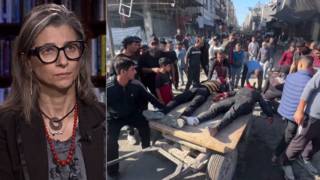
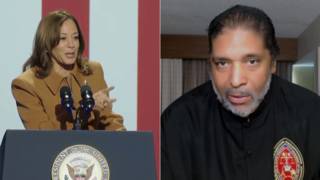
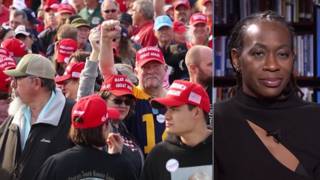
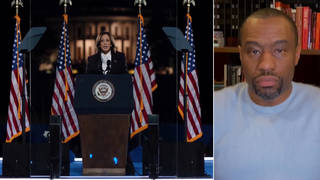



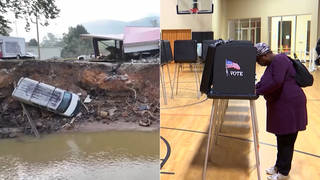

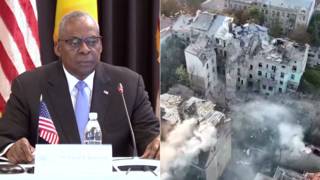

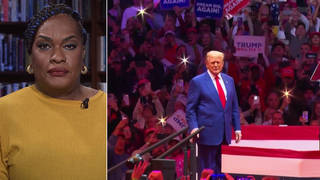
Media Options